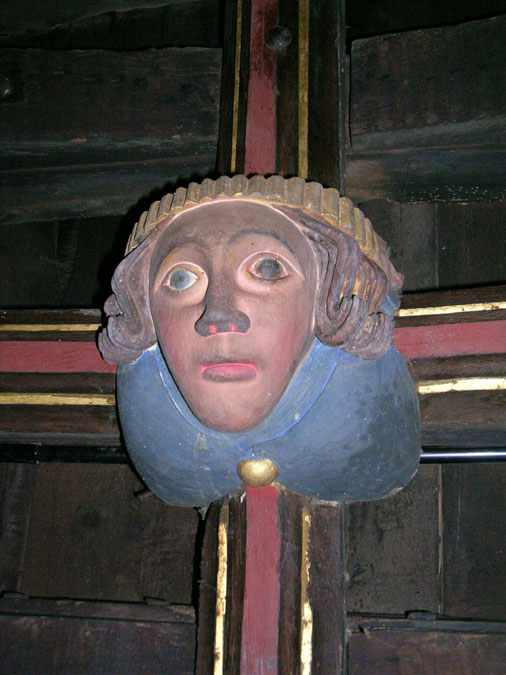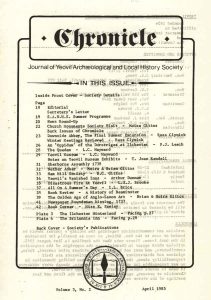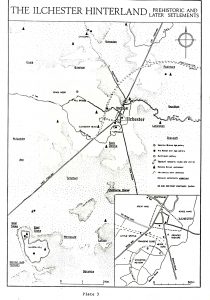This article came from the Chronicle published April 1985. Pages 23-26
The final Summer Excursion
and
Winter Meetings Reviewed
Author: Russ Clynick
THE FINAL SUMMER EXCURSION.
DOWNSIDE ABBEY. The last of the summer excursions was to the Abbey Church of St. Gregory at Downside, near Bath on 22nd September.
It is one of the largest and finest examples of the Neo-Gothic style in England. In the tradition of most of the great medieval churches, its design and construction (still not complete) has been spread over more than 100 years and has been the responsibility of at least six major architects. Its fittings and embellishments are the products of a large number of artists and designers.
We were welcomed by the Guestmaster, Father Aidan, who conducted us on an extensive tour of the Abbey, pointing out the major components of the church – the choir, sacristy, lady chapels, the transepts. The numerous side-chapels, all dedicated to martyrs, bishops acid saints in some cases contained their tombs. The whole building is of a grand scale, lofty and of fine proportions. The modern stained glass is rich and plentifully distributed throughout the Abbey.
In addition to the Abbey church proper we were shown the extensive and important library widely used in research, where we were given an account of the internationally famous Downside School, which educates just over 600 boys – mostly boarders. The school occupies a significant proportion of the entire Abbey complex.
Father Aidan was warmly thanked by our chairman, Bill Chapman, at the conclusion of what was altogether a very entertaining visit.
(Russ Clynick.)
WINTER MEETINGS REVIEWED.
MUSICAL INSTRUMENTS OF THE VICTORIA AND ALBERT MUSEUM. The Society’s winter programme opened on 5th October with the Edgar Silcox memorial lecture, which was given by Mr. J.A. Cervenka of the Victoria and Albert Museum. He showed some outstanding slides accompanied by a taped commentary which traced the origin and development of many of the musical instruments, now in general use, and that we take for granted.
As an introduction, we saw a particularly fine slide showing a virginal made for and used by Elizabeth 1.
There followed examples of instruments developed over the past four centuries including the oboe, lute, horn, harpsichord, bass-viol and flute. In all cases it involved the finest craftsmanship in construction with delicate and elaborate ornamentation. The material used included ivory, ebony, silver and exotic woods.
The curious bariton or bass-viol was described which was played by bowing and plucking, together with the hurdy-gurdy and the harpsichord, forerunner of the present day pianoforte.
The examples shown were only part of the great collection from the V and A.
Miss Isobel Rendell expressed our thanks and appreciation to Mr. Cervenka for a most enjoyable event. Mrs. Silcox was a very welcome guest for the evening.
RECENT ARCHAEOLOGICAL WORK IN ILCHESTER. The second of the winter lectures was given by Peter Leach of the Western Archaeological Trust on 2nd November. He described the brief excavation he had conducted during October 1984 just south of Ilchester on a site which was only discovered during flooding in 1979. His lecture was well illustrated by slides and the society
Detailed analysis and interpretation of the site had still to be carried out but the evidence pointed to the discovery of a rare Iron Age oppidum which immediately preceded the Roman development of the area.
Mr. Leach emphasised that research will still go on and he hopes to be working again at Ilchester this year.
He was warmly thanked for his lecture by Mr. Hayward, who also congratulated him on his appointment to an “Archaeological Unit” working with Birmingham University.
(Mr. Leach has kindly contributed a summary of his recent work at Ilchester including a detailed map of the area is shown on the right)
Meetings and outings were generally very well attended but some of the excursions could have been better supported. Membership had increased during the year – a very healthy sign.
Copies of the treasurer’s report were circulated at the meeting and it indicated a satisfactory financial situation.
Our Chairman in his remarks, spoke of his appreciation of the work of the officers and committee, resulting in the smooth running of the society’s activities. Using the analogy of the society being like a viking ship with the chairman as the figurehead and members as crew, he expressed great pleasure at tile way we had sailed through the year’s tranquil waters.
The Editor expressed his thanks for all the help received but mentioned that no new publications were contemplated. He emphasised that contributions for the next issue of Chronicle should be in by February 1985, that many more would be welcome and that he would do his best to maintain the high standard which had been set for the society’s journal.
All the reports were received and adopted. The election of officers and the committee resulted in the following:-
| Chairman | Bill Chapman |
| Secretary | John Moon |
| Treasurer | Paul Gardner |
| Editor | Brian Gittos |
| Librarian | Enid Pawley |
| Committee | Leslie Brooke, Pat Knight and Robin Ansell. |
The chairman expressed the apprciation of the meeting for all that had been done to make it such a success.
MEMBERS NIGHT. on 4th January was the occasion for a most interesting and well illustrated talk given by our chairman, Bill Chapman. His subject was “The History and Architecture of Ely Cathedral”. He outlined the history of Ely from its foundation as a religious house by Queen Etheldreda in AD 673 (according to Bede) up to the present time. In some respects it was a turbulent history, including destruction by the Danes and the collapse of the central Norman tower.
The series of excellent slides showed us the many architectural styles employed in its building and the many changes brought about as it developed. Features pointed out included the misericords, the carved pillar capitals and the unique octagonal lantern tower above the crossing, the latter being a remarkable example of medieval craftsmanship in timber.
Ely possesses a wealth of elaborate carving in both wood and stone. Its several styles of building are easily discernable being predominantly Norman but including Saxon and other periods right up to Wren.
The speakers easy style, his enthusiasm for this lovely church, together with the amount of research he had undoubtedly undertaken, all combined to make it a most entertaining and inspiring evening.
Isobel Rendell warmly thanked Bill on behalf of the Society.
THE EAST SOMERSET RAILWAY. Members may recollect that in May last year our society visited the East Somerset Railway at Cranmore. It was a very unpleasant day as far as weather was concerned but we were given a conducted tour by Mr. A. French and were shown a very fine example of industrial archaeology.
On 1st February 1985 Mr. French visited the society to give, in more detail and with the help of many excellent slides, the complete story of the rebirth of this railway complex. It is the brain child of the famous wild-life artist and conservationist, David Shepherd. Mr. French’s illustrations showed the transition from wrecks to “good-as-new” locomotives, most of them with well-known names and fully operational.
All the main features of the former station at Cranmore were shown, booking office, signal box (now a museum and art gallery) waiting-room and Victorian “Temple of Convenience” together with a good stretch of well laid track, engine sheds and workshop. In contrast to the gloomy, damp and depressing scene which we saw on our visit, the slides were colourful and bright and gave a far more cheering picture which prompted the thought that another visit in better weather might be made.
Mr. French’s “racy” style and his undoubted enthusiasm for his subject, contributed greatly to the enjoyment of the talk. He was warmly thanked by our chairman.
(Russ Clynick.)


